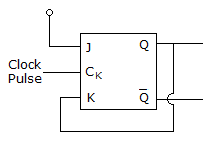ECE :: Digital Electronics
-
What is the direction of control bus?
-
In the given figure assume that initially Q = 1 with Clock Pulses being given, the subsequent states of Q will be

-
The Boolean expression (A + B) (A + C) (B + C) simplifies to
-
If Vin is 0.99 V, what is the digital output of the ADC 0801 after INTER goes low?
-
Which of the following operation are performed on linear queues?
- Testing a linear queue for underflow
- Enqueue operation
- Dequeue operation
- Testing a linear queue for overflow.
-
As access time is decreased, the cost of memory
-
Assertion (A): Hamming code is commonly used for error correction
Reason (R): In Hamming code the number of parity bits increases as the number of information bits increases.
-
A 2 bit binary multiplier can be implemented using
-
A microcomputer has memory locations from 0000 to FFFF, each storing 1 byte. How many bytes can be the memory store?


 Whatsapp
Whatsapp
 Facebook
Facebook

